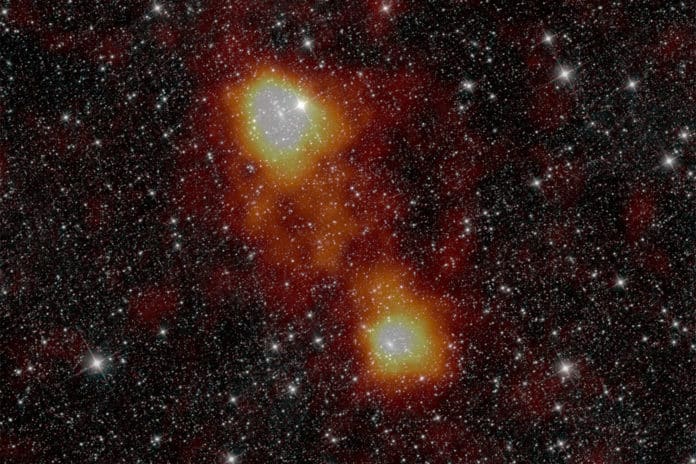By gazing at the cosmic web, astronomers at the University of Toronto have spotted some of the most elusive stuff in our universe. They detected the diffuse, hot gas in a roughly 40 million light year-long filament between two clusters of galaxies.
Although galaxies generate most of the visible light, they still contain fewer than 10 percent of all the atoms in the cosmos. Most of the remaining matter is found in the cosmic web as a diffuse gas with a density of only one atom per cubic foot of space, much lower than the highest level of vacuum ever attained on Earth.
It is extremely difficult to detect the gas because of its thinness. This is referred to as the ‘missing baryon problem. In recent years, however, astronomers have finally discovered these elusive atoms.
This discovery was made using archival data from the Planck satellite and more recent data from the Atacama Cosmology Telescope (ACT) in northern Chile, which looks at the Cosmic Microwave Background (CMB), the oldest light in the universe.
The scientists observed how the gas in the filament scattered the CMB light. They discovered that the gas in the filament contains around 50 billion times more mass than our own Milky Way Galaxy or the mass of 50 billion suns.
The larger ACT sensor sharpened the image significantly, contrasting the galaxy clusters and the filament much clearer, despite the fact that this system’s evidence for the filamentary gas had already been discovered using the Planck data.
While the findings focused on missing baryons in a particular set of galaxies, the next goal was to determine how this gas is distributed in an ensemble of special regions of the cosmic web.
Martine Lokken, a Ph.D. student in U of T’s astronomy and astrophysics department, used data from the Dark Energy Survey to identify nearly 1,000 galaxy clusters that live in regions of the universe likely to be permeated by filament gas that is denser and hotter than the average.
By combining their extended gas signal in the Planck and ACT data, she found that gas in the clusters and filamentary patterns extended away from the clusters. These are expected to contain a great deal of diffuse gas.
Lokken said, “Our work demonstrates a new way to study gas in the cosmic web. Accounting for all the so-called ‘missing baryons’ is one of the most important tasks we as cosmologists need to tackle. Our directional studies of cosmic gas are a new way to probe this problem and other questions about the origins of our universe.”
Journal References:
- M. Lokken et al., Superclustering with the Atacama Cosmology Telescope and Dark Energy Survey. I. Evidence for Thermal Energy Anisotropy Using Oriented Stacking, The Astrophysical Journal (2022). DOI: 10.3847/1538-4357/ac7043
- Adam D Hincks et al., A high-resolution view of gas filament between Abell 399 and Abell 401 from the Atacama Cosmology Telescope and MUSTANG-2, Monthly Notices of the Royal Astronomical Society (2021). DOI: 10.1093/mnras/stab3391
